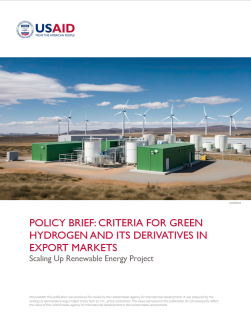Criteria for Green Hydrogen and its Derivatives in Export Markets
Scaling Up Renewable Energy (SURE)
Policy Brief –
The production and export of green hydrogen (H2) and its derivatives is poised to become a strategic industry for many countries.
Energy planning determines when, where, and how to invest. When done well, today’s decisions address tomorrow’s needs and challenges.
As prices for clean energy and storage technologies continue to fall and nations race to cut emissions under the Paris Agreement, power utilities must be able to integrate higher shares of renewable energy strategically to meet growing energy demand and increase the number of people with access to electricity. Poor resource planning can cause energy shortages and service interruptions (e.g., load shedding), lead to energy surpluses that raise electricity prices due to supply and demand imbalance, and increase vulnerability to fossil fuel price fluctuations and emissions.
Green hydrogen (H2) can play a role in energy planning by helping countries reduce reliance on fossil fuels and meet climate goals. Enthusiasm is building around green H2's potential due to anticipated cost reductions in the next decades and H2’s contribution toward achieving net-zero carbon dioxide (CO2) emissions in energy-intensive, hard-to-decarbonize sectors like steel, chemicals, long-haul transport, shipping, and aviation.
Relevance of H2 sustainability criteria
Countries that have limited domestic opportunities to produce low-cost, low-emission H2 may have to rely on H2 imports. Potential exporters of H2 or its derivatives, such as green ammonia or green methanol, will need to certify that their products comply with the sustainability criteria of the respective importing jurisdictions, such as the European Union (EU), Germany, South Korea, and Japan.
Instruments defining H2 sustainability criteria
H2 sustainability criteria refer broadly to the product specifications for H2 or derivatives regarding environmental (e.g., greenhouse gas (GHG) emissions intensity, electricity and CO2 sourcing, and impact on water resources) and social (e.g., land-use rights, labor standards including health and safety, and local benefit sharing) sustainability criteria.
Regulations, standards, and certification schemes define and enable the implementation of H2 sustainability criteria.
Green H2 as an element of H2 sustainability criteria
Addressing environmental and social impacts from the project’s outset can help avoid or mitigate harms and is often a requirement to secure project funding from development finance institutions and access import markets (and their support schemes).
This policy brief focuses on green H2 as defined in EU regulation, namely based on the GHG emissions intensity of the H2 value chain and the origin of the electricity used to produce electrolysis-based H2 and carbon for synthetic fuels.
Case study: Sustainability criteria for green H2 in the European Union (EU)
Different H2 project setups result in different compliance requirements for the export of green H2 into the EU. Compliance for green H2 projects with an insular electrolyzer (“off-grid” model) is generally less complex than for non-insular electrolyzers. Proving compliance for projects with a non-insular electrolyzer (“on-grid” model) requires proof that the renewable electricity used during production is additional and does not divert renewable electricity away from power sector decarbonization, and that the electricity used is temporally and geographically correlated with H2 production.
Key takeaways for countries exporting green H2
National H2 strategies should envision the quantities of renewable energy needed for domestic consumption and to achieve national climate targets. Countries with abundant renewable energy sources can also look toward the quantities available to produce green H2 and its derivatives for export, carefully weighing affordability of various sources since wind and solar are still the cheapest sources of renewable energy.
Green H2 project setup and operation should follow the sustainability criteria of the target market. Globally, H2 regulations, standards, and certification processes are still under development, but key criteria are emerging and there are early efforts to coordinate standards internationally. As of June 2023, the EU had adopted the most comprehensive green H2 criteria.
Certain EU rules require further definition regarding their applicability in contexts outside the EU. The evolving certification systems to operationalize EU sustainability standards will likely play a key role in defining open issues. Other import countries (e.g., Korea and Japan) are developing green H2 criteria as well, and international efforts to establish common standards are gaining momentum.
SURE can support partner countries with capacity building on green H2 sustainability criteria and with identifying domestic policies that support the market ramp-up of green H2 and its derivatives.



